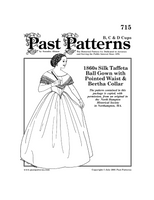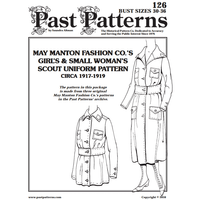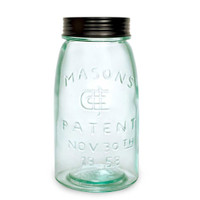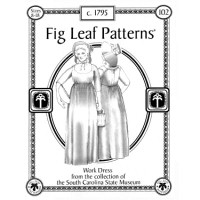 Loading... Please wait...
Loading... Please wait...Categories
Add to Wish List
New Products
- Home
- Historic Patterns
- Women's
- Regency (1790-1820)
- Work Dress c. 1795
Product Description
The work dress that this pattern is derived from is unusual in that the fabric was woven in 1781 on the family plantation in Edgefield County, South Carolina, but the gown was not created until later. It was made of bleached linen with red and blue stripes.
The gown, which is hand sewn and shows signs of patching on the shoulder, was made up sometime in the mid 1790's and shows the transitional style of a higher waistline. The bodice front neckline is low and curved with edges turned under first and then the center front seam was stitched. The bodice also ends high under the bust and has three darts on each side for shaping and extends around the body as in the earlier "en fourreau" style. Unlike the early style, the back of the bodice has no tucks or seams, but both the neck line and the waistline have drawstrings encased in the seams which begin at the shoulder seam and side back seam. This kind of construction allows the back to adjust in fit. The shoulder strap is constructed in the same manner as earlier styles and has two sets of patches. Sewn on the front of the bodice under the bust are two hooks, presumably for an apron to hook on. The sleeves are two-piece construction with a narrow hem.
It appears that the bodice, which is unlined, is finished separately from the skirt and then applied to the skirt. The skirt is made from two squares and two triangle-shaped pieces which are set at the sides of the body. There are pocket slits in the front seams. The hem, which is narrow, at one time was shortened at center back to reduce the length of the train.
Find Similar Products by Category

Product Reviews
-
a little too authentic

Posted by Unknown on 13th Jul 2017
This is a very well made pattern with extensive well written instructions and authentic sewing tips. My main problem with this pattern is it was made from a poorly constructed original dress and, whereas I applaud the person who drafted this exactly, I would have rather have had a pattern that gave the option of making the dress correctly (as if the original dressmaker had enough fabric and a little more skill). I redrafted this pattern to what I found more effective. Definitely not a beginner pattern. I look forward to using other patterns from Fig Leaf hoping they were drafted from better constructed original garments.









